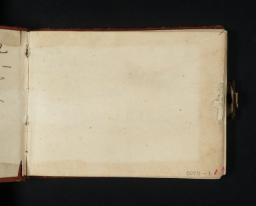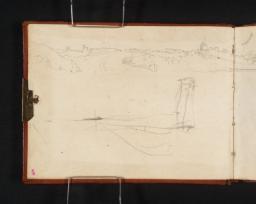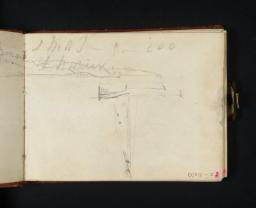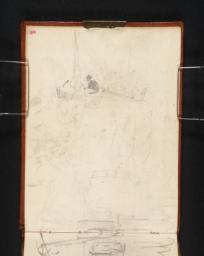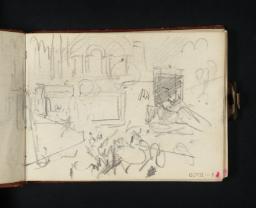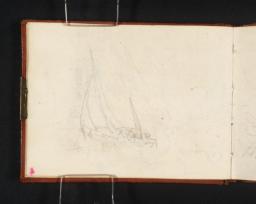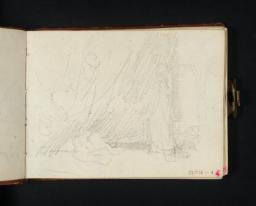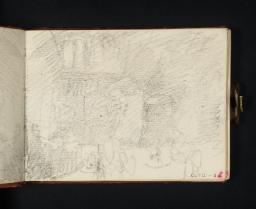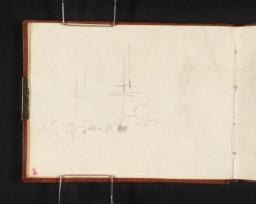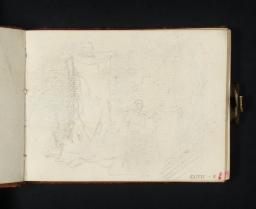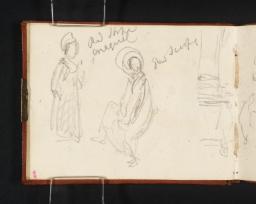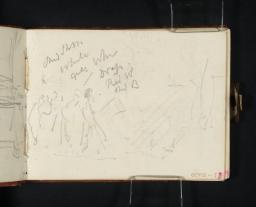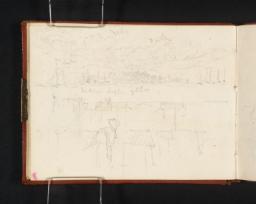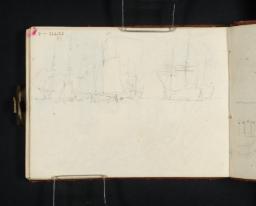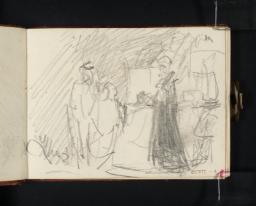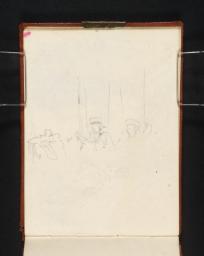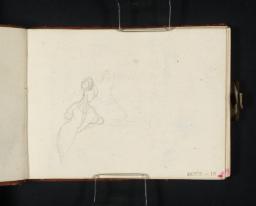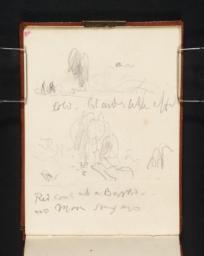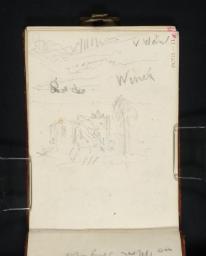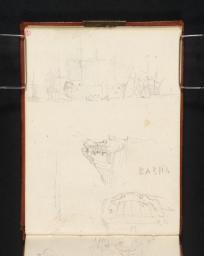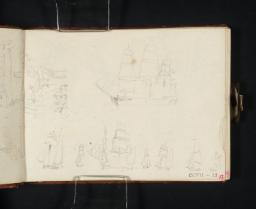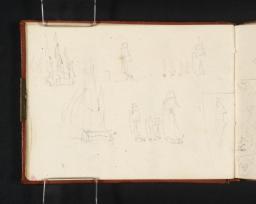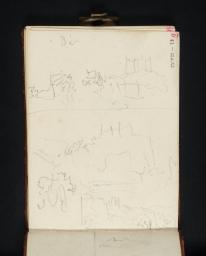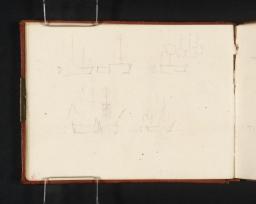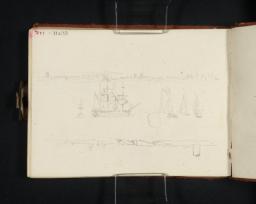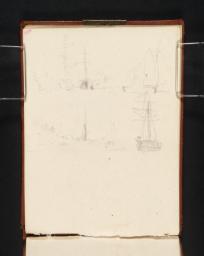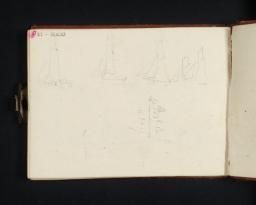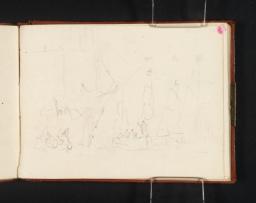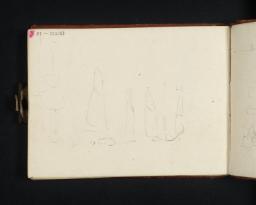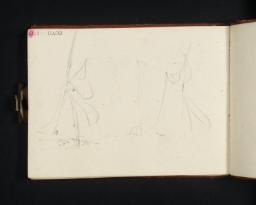Turner Bequest CCVII 1–74a
Sketchbook bound in boards, covered in brown leather; one brass clasp
74 leaves and paste-downs of white wove paper; page size 74 x 100 mm
Stamped in black ‘CCVII’ on front cover, top right
Numbered 392 as part of the Turner Schedule in 1854 and endorsed by the Executors of the Turner Bequest, Scott Trimmer, Charles Turner, Charles Lock Eastlake and John Prescott Knight, in ink ‘No 392 Contains 72 | leaves. Pencil sketches – | H.S. Trimmer | C Turner’, and initialled in pencil ‘C.L.E.’ and ‘JPK’, inside front cover, from top
Inscribed in pencil ‘CCVII’ inside front cover, top left
Stamped in ink ‘CCVII’ inside front cover, towards top left
74 leaves and paste-downs of white wove paper; page size 74 x 100 mm
Stamped in black ‘CCVII’ on front cover, top right
Numbered 392 as part of the Turner Schedule in 1854 and endorsed by the Executors of the Turner Bequest, Scott Trimmer, Charles Turner, Charles Lock Eastlake and John Prescott Knight, in ink ‘No 392 Contains 72 | leaves. Pencil sketches – | H.S. Trimmer | C Turner’, and initialled in pencil ‘C.L.E.’ and ‘JPK’, inside front cover, from top
Inscribed in pencil ‘CCVII’ inside front cover, top left
Stamped in ink ‘CCVII’ inside front cover, towards top left
Accepted by the nation as part of the Turner Bequest 1856
Exhibition history
References
This small sketchbook has been renamed here as largely relating to Turner’s 1827 visit to the Isle of Wight in connection with the regatta events at Cowes. Numerous sketches relate, whether intentionally or fortuitously, to the oil sketches and paintings Turner produced on the subject, as discussed below. The ‘Gosport’ of the sketchbook’s traditional title, which Gerald Wilkinson has noted as ‘confidently labelled’ but ‘not on any authority from Turner’1 appears essentially to have no relevance to its contents (although two pages possibly comprise distant views of Gosport and neighbouring Portsmouth in Hampshire; see later in the Introduction). The name seems to have originated with John Ruskin; Finberg notes ‘Mr. Ruskin’s endorsement’ on a wrapper (since lost): ‘392. Curious little marines, and sketch of boats at Gosport.’2
Currently, the only clearly identified sketches of Gosport, across the harbour from Portsmouth, are in the London Bridge and Portsmouth sketchbook of about 1824 (Tate D17922, D17924, D17930, D17940–D17942, D17950–D17951; Turner Bequest CCVI 5a, 6a, 9, 14, 15, 15a, 19a–20), and a single view in passing in the later Guernsey book (Tate D23572; Turner Bequest CCLII 28). Nevertheless, the present book’s former title has led to its being spuriously associated in general terms3 with the watercolour Gosport, Entrance to Portsmouth Harbour, of about 1829 (Portsmouth Museums and Records),4 engraved in 1831 for the Picturesque Views in England and Wales (Tate impressions: T04574, T04575).
While retaining its established title and dating, Ann Chumbley and Ian Warrell observed: ‘Like sketchbooks used at the Cowes Regatta off the Isle of Wight in 1827, this book contains studies of both the shipping and the figures watching from the shore.’5 Gerald Wilkinson called it a ‘very small book of ships and holidaymakers’ noting that Turner seems to have ‘had time to relax on the sea front ... and the results are very pretty.’6 Among various figure studies, Chumbley and Warrell noted in particular those with telescopes on folios 33 recto and 36 recto (D18052, D18058), children playing on an upturned boat on folio 44 verso (D18074), and also the attention paid to women’s outfits, including their bonnets 36 verso (D18059) and ‘dresses blown by the wind’ on folio 19 recto (D18024).7
When cataloguing Turner’s paintings relating to his 1827 stay at East Cowes Castle (see the overall Introduction to the present section), Martin Butlin and Evelyn Joll were presumably deflected from investigating this sketchbook by its supposed Gosport connection and earlier dating, referring instead to the long recognised Windsor and Cowes, Isle of Wight book (Tate; Turner Bequest CCXXVI) as containing ‘drawings of boats racing, boats at anchor, views of the coast and figure studies, though none directly related to the oil sketches, which to a certain extent supports the suggestion that they were done on the spot.’8 This last point addresses Graham Reynolds’s long article on the Cowes material in general, where he suggested that Turner made the oil sketches ‘from the water’s edge, or from a boat on the water’;9 Evelyn Joll further proposed that Turner may have done them from a warship moored in Cowes Roads.10 Turner also had a room to work in at back at the castle.11
The artist’s host, the architect John Nash (1752–1835), commissioned two oil paintings which were exhibited at the Royal Academy in 1828: East Cowes Castle, the Seat of J. Nash, Esq.; the Regatta Beating to Windward (Indianapolis Museum of Art),12 and East Cowes Castle, the Seat of J. Nash, Esq.; the Regatta Starting for their Moorings (Victoria and Albert Museum, London).13 The first, a depiction of an exciting sporting event at sea, might be regarded as active and ‘Romantic’, contrasting with the deceptively calm and more passive ‘Classical’ river scene in the second, equally busy is its way with rowing boats and spectators. There are three oil sketches for the Indianapolis painting, listed below with reference to the pencil studies here of the forms and dynamics of yachts under sail and manoeuvring in relation to other craft; although there is no outright evidence of specific connections, the drawings might be regarded as working data for the oils:
Sketch for ‘East Cowes Castle, the Regatta Beating to Windward’ No.1 (Tate N01995);14 see folio 31 verso (D18049)
Sketch for ‘East Cowes Castle, the Regatta Beating to Windward’ No.2 (Tate N01994);15 see folio 3 verso (D17996)
Sketch for ‘East Cowes Castle, the Regatta Beating to Windward’ No.3 (Tate N01993);16 see folios 24 recto, 25 recto and 27 verso (D18034, D18036, D18041)
Sketch for ‘East Cowes Castle, the Regatta Beating to Windward’ No.2 (Tate N01994);15 see folio 3 verso (D17996)
Sketch for ‘East Cowes Castle, the Regatta Beating to Windward’ No.3 (Tate N01993);16 see folios 24 recto, 25 recto and 27 verso (D18034, D18036, D18041)
A considerable number of drawings can be related to aspects of the finished Beating to Windward painting: see folios 11 verso, 12 verso, 20 recto and verso, 24 verso, 25 recto, 27 verso, 30 recto, 32 verso, 34 verso, 35 recto, 37 recto, 38 verso and 57 verso (D18010, D18012, D18026, D18027, D18035, D18036, D18041, D18046, D18051, D18055, D18056, D18060, D18063, D18100). A more pictorial study of yachts in testing condition on folio 71 recto (D18126) may have served as a working idea for a racing composition. For sketches featuring East Cowes Castle, see under folio 22 recto (D18030).
Perhaps understandably, fewer sketches seem to relate to the oil sketches for the serene Victoria and Albert Museum painting:
Sketch for ‘East Cowes Castle, the Regatta Starting for their Moorings’ No.1 (Tate N01998);17 see folio 5 verso (D17999), which is only loosely comparable
Sketch for ‘East Cowes Castle, the Regatta Starting for their Moorings’ No. 2 (Tate N02000);18 no likely related drawings
Sketch for ‘East Cowes Castle, the Regatta Starting for their Moorings’ No.3 (Tate N01997);19 no likely related drawings
Sketch for ‘East Cowes Castle, the Regatta Starting for their Moorings’ No. 2 (Tate N02000);18 no likely related drawings
Sketch for ‘East Cowes Castle, the Regatta Starting for their Moorings’ No.3 (Tate N01997);19 no likely related drawings
In terms of the finished Starting for their Moorings subject, the following drawings have some relevance: see folios 8 recto, 28 recto, 31 recto, 41 verso, 42 recto, 46 recto, 73 recto (D18004, D18042, D18048, D18069, D18070, D18077, D18130). For Cowes Castle, the operational fort just obtruding on the right of the painting as little more than a foil to the glamour of the mock-martial East Cowes Castle, see under folio 19 verso (D18025). Another painting, Shipping off East Cowes Headland (Tate N01999)20 takes the vicinity of Cowes Castle as its viewpoint, and can be directly related to drawings on folio 7 verso (D18003); see also folios 19 verso and 40 recto (D18025, D18066).
Butlin and Joll mention the ‘list of the boats with their names, the names of their owners, and their colours, showing just how interested was Turner’s interest in the [1827] Regatta’,21 in the Windsor and Cowes, Isle of Wight sketchbook (Tate D20730; Turner Bequest CCXXVI 80a). That page, which also includes colour notes and diagrams of the yachts’ flags, can be cross-referenced with two pages in the present book: the Miranda, which features in the Windsor and Cowes notes, is actually depicted and labelled as such on folio 70 verso (D18125); diagrams of flags and associated names including an abbreviated ‘Mir’ on folio 74 verso (D18133) also tally.
The two paintings commissioned by Nash naturally make a feature of the imposing home of his own design. An image intended for wider circulation shows another building of his, St Mary’s Church on the opposite bank of the River Medina. Turner’s watercolour Cowes, Isle of Wight (private collection)22 was engraved in 1830 for the Picturesque Views in England and Wales (Tate impressions: T04556, T06086, T06087); it is based on the view on folio 21 recto (D18028). The England and Wales subject is a peaceful twilight scene, contrasting again with the differing moods of the paintings.
In terms of other Isle of Wight subjects, Norris Castle, a building similar to nearby East Cowes Castle, features on folio 1 verso (D17992). Folio 11 recto (D18009) may show St Michael’s Church, Shalfleet, while a paddle-steamer was observed off Ryde on folios 34 recto and 35 verso (D18055, D18056). Turner seems to have undertaken one or two voyages during his stay on the island: folio 13 recto (D18013) appears to show Dover Castle, Kent, and the lightship at the Goodwin Sands, off the eastern end of the county, is noted on folio 37 verso (D18061). It is possible that slight views on folio 14 recto (D18015) may actually show Gosport and neighbouring Portsmouth in the distance, and folio 34 verso (D18055) may be a nearer view. A more substantial sequence of drawings between folios 58 verso and 69 recto (D18102–D18123) was mostly made along Southampton Water, not far across the Solent from Cowes, ranging from Calshot Castle (see folios 60 verso and 61 recto; D18106, D18107) up as far as Southampton itself. Finberg’s tentative identification of folios 61 verso–62 recto (D18108–D18109) as showing the town23 is the only one confirmed of the very few he attempted for the whole book.
Not unusually for one of Turner’s sketchbooks, there are a few miscellaneous drawings outside the main themes, falling in this case near the beginning. Folios 4 recto, 6 recto and 9 recto (D17997, D1800, D18005) show interiors with figures in obscure circumstances which might be ideas for historical or even erotic subjects, while folios 2 verso–3 recto, 5 recto and 6 verso–7 recto (D17994–D17995, D17998, D18001–D18002) may record an actual gathering inside a large building, perhaps in London.
See Clark, Davidson and Gage 1964, p.29, Wilkinson 1975, p.28, Wilton 1979, p.397, Warrell 1991, p.36, and Piggott 1998, p.5.
Martin Butlin and Evelyn Joll, The Paintings of J.M.W. Turner, revised ed., New Haven and London 1984, p.159.
Technical notes
How to cite
Matthew Imms, ‘Cowes Regatta Sketchbook 1827’, sketchbook, December 2014, in David Blayney Brown (ed.), J.M.W. Turner: Sketchbooks, Drawings and Watercolours, Tate Research Publication, November 2016, https://www

